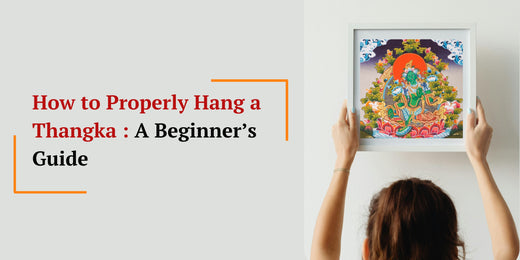
Uses of Thangka painting
Introduction:
Thangka paintings stand as exquisite reflections of Tibetan Buddhist heritage, encapsulating centuries of spiritual wisdom and artistic mastery. Originating from the devout practices of Tibetan monks, these intricate artworks carry profound symbolic meanings, each stroke conveying a deeper spiritual message. While their visual allure is undeniable, Thangkas transcend mere ornamentation, serving as conduits for meditation, prayer, and contemplation. In the vast expanse of Tibetan culture, they represent a tangible link to the spiritual realm, inviting devotees into a sacred space of introspection and reverence. Throughout history, Thangka paintings have evolved from religious artifacts to revered treasures, weaving a narrative of devotion and enlightenment that continues to resonate across cultures and generations. In this blog, we'll explore the diverse uses of Thangka paintings, shedding light on their significance in different contexts.
1.Religious Practices:
Thangka paintings serve as conduits for spiritual connection in Tibetan Buddhist rituals. Adorned with intricate depictions of Buddhas, bodhisattvas, and sacred symbols, they become focal points during prayer and meditation sessions. Through their detailed craftsmanship and vibrant colors, Thangkas facilitate deep contemplation, guiding practitioners on their spiritual journeys. Beyond mere aesthetic appeal, these paintings are believed to possess inherent spiritual energy, capable of invoking divine blessings and protection. In temples and monasteries, Thangkas play integral roles in religious ceremonies, reinforcing the bond between devotees and the divine.

2.Educational Tools:
Within Tibetan monastic traditions, Thangka paintings play vital roles as educational aids. They serve as visual representations of Buddhist teachings, aiding in the transmission of complex philosophical concepts. Monks and scholars use Thangkas to elucidate intricate aspects of cosmology, iconography, and metaphysics, making abstract ideas more tangible and accessible to students. Through detailed iconography and symbolism, Thangka paintings encapsulate profound spiritual truths, serving as mnemonic devices for memorization and contemplation. In this way, Thangkas become indispensable tools for the preservation and dissemination of Buddhist wisdom across generations.
3.Cultural Heritage:
Thangka paintings stand as proud symbols of Tibetan culture and heritage, embodying centuries of artistic tradition and spiritual devotion. Rooted in ancient Buddhist iconography, these artworks capture the essence of Tibetan identity and belief systems. Passed down through generations, Thangkas serve as repositories of historical narratives, mythologies, and artistic techniques unique to the Himalayan region. As tangible expressions of Tibetan spirituality, they bridge the gap between past and present, fostering a sense of continuity and pride among Tibetan communities worldwide. Through their preservation and appreciation, Thangkas safeguard the cultural legacy of Tibet for future generations.

4.Meditation and Mindfulness:
In modern contexts, Thangka paintings have transcended their religious origins to become tools for meditation and mindfulness practices. Their intricate designs and symbolic imagery provide points of focus for individuals seeking inner peace and spiritual growth. Whether in meditation rooms or yoga studios, Thangkas create sacred spaces conducive to introspection and tranquility. By immersing oneself in the intricate details of these paintings, practitioners can deepen their mindfulness practices, cultivating awareness and presence in the present moment. Through the beauty and symbolism of Thangkas, seekers of inner peace find inspiration and solace on their spiritual paths.
5.Decorative Art:
Beyond their spiritual and cultural significance, Thangka paintings have emerged as sought-after decorative pieces in contemporary settings. Their exotic allure and vibrant colors make them captivating additions to homes, offices, and meditation spaces. Whether displayed as wall hangings or framed artworks, Thangkas infuse spaces with a sense of elegance and cultural sophistication. As conversation starters and focal points of admiration, these paintings evoke curiosity and appreciation for Tibetan artistry and craftsmanship. Through their presence in diverse environments, Thangkas continue to bridge cultural divides and inspire appreciation for the beauty of Eastern traditions.



